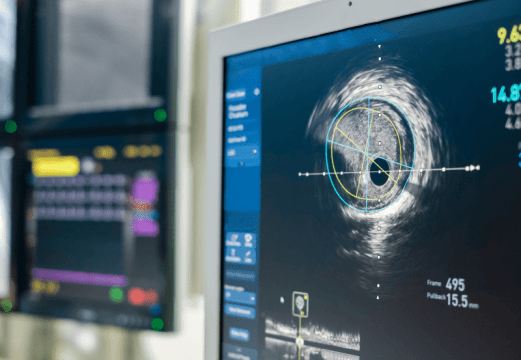Lesions in the left main coronary artery (LMCA) continue to pose a significant challenge. The use of coronary imaging before percutaneous coronary implantation (PCI) has proven useful in analyzing the lesion, identifying the presence and location of calcification, and determining lesion length in the LMCA, the left anterior descending artery, and the circumflex artery.

Various studies have revealed that incorporating techniques like IVUS or OCT has not only improved the clinical course of patients but has also resulted in reduced mortality.
For instance, the ULTIMATE Trial demonstrated a reduction in adverse events such as stent thrombosis with the use of IVUS, while the ROCK I and ROCK II studies showed better clinical outcomes with OCT.
Additionally, the EBC MAIN Study showed that using a single stent had better outcomes compared with two-sent implantation.
A specific analysis of the EBC MAIN Study included patients with lesions in the unprotected LMCA with type 1.1.1 or 0.1.1 bifurcation lesions according to the Medina Classification.
Researchers analyzed a total of 455 patients, with 226 undergoing PCI with provisional stenting (coronary imaging was used in 91 of these cases) and 229 undergoing two-stent implantation (88 of them with coronary imaging). All patients received antiplatelet therapy with acetylsalicylic acid (ASA) and clopidogrel for at least 6 months. The decision to use two stents was left at operator’s discretion.
Read also: Transcatheter Closure of Patent Foramen Ovale in Thrombophilia Patients.
The primary endpoint (PEP) assessed was all-cause death, myocardial infarction, or target vessel revascularization (TVR) at 12 months.
The average patient age was 71 years, and 77% of subjects were men. Most had stable coronary syndromes. There were no significant differences in risk factors between the two groups, nor in the complexity of lesions evaluated using the SYNTAX Score.
Coronary imaging was used in 179 patients. IVUS was more frequently used compared with OCT (151 vs. 28 patients), with a similar distribution among those who received one or two stents. There were no differences in the type of balloon used or the application of techniques such as cutting balloon, rotational atherectomy, or lithotripsy. The most frequently used strategy with two stents was the “crush” method, followed by TAP or the use of a “T”-shaped stent.
Read also: TAVR in Asymptomatic or Minimally Symptomatic Patients: 30-Day Results.
At the one year of follow-up, there were no significant differences between patients guided by imaging and those guided solely by angiography in terms of the PEP (17% vs. 16%; odds ratio [OR]: 0.92 [95% confidence interval (CI): 0.51−1.63], p = 0.767; hazard ratio [HR]: 0.94 [95% CI: 0.55−1.59], p = 0.812) or in reinterventions (14% vs. 16%; OR: 0.88 [95% CI: 0.32−2.43], p = 0.803), even after adjusting for the Syntax Score, the presence of calcified lesions, or the presence of ischemia. There were no differences when comparing the angiography vs. IVUS or OCT vs. no OCT subgroups.
However, when comparing patients guided solely by angiography, researchers found that those who received two stents had a significantly higher PEP compared with those who received only one stent (21% vs. 10%; adjusted OR: 2.11 [95% CI: 1.04−4.30], p = 0.039; adjusted HR: 2.00 [95% CI: 1.04−3.83], p = 0.038). Conversely, when analyzing patients who received one or two stents and were guided by imaging, there was a trend toward a higher PEP in the two-stent group, although this difference did not reach statistical significance (13% vs. 21%; adjusted OR: 0.56 [95% CI: 0.22−1.46], p = 0.220).
Conclusion
In summary, in the EBC MAIN Study, there were no significant differences in the primary endpoint between the use of intracoronary imaging and angiography alone. However, in patients guided exclusively by angiography, clinical outcomes were better for those who received provisional stent placement instead of two stents. When intracoronary imaging was used, there was a trend toward better outcomes with the two-stent strategy compared with the single-stent strategy.

Dr. Carlos Fava.
Member of the Editorial Board of SOLACI.org.
Original Title: Bifurcation left main stenting with or without intracoronary imaging: Outcomes from the EBC MAIN trial.
Reference: Annette Maznyczka, et al. Catheter Cardiovasc Interv. 2023;102:415–429.
Subscribe to our weekly newsletter
Get the latest scientific articles on interventional cardiology





